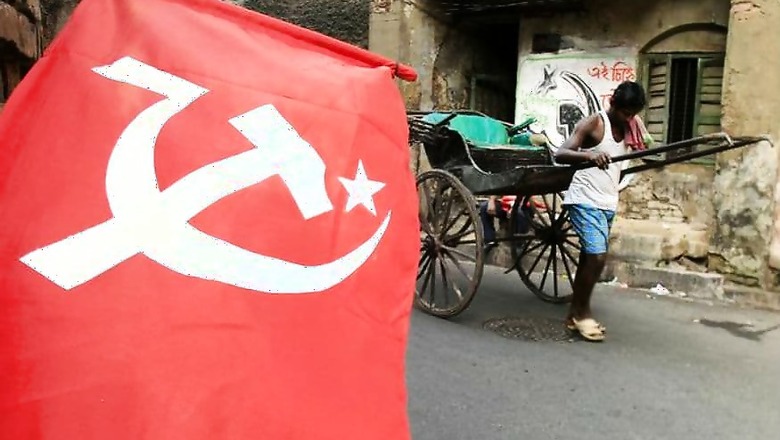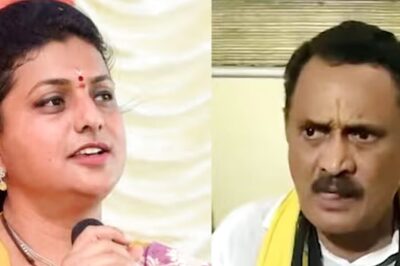
views
It all started on April 7, 2019.
Deafening slogans of "Lal Salam, Lal Salam, Inquilab Zindabad" broke the eerie silence of Nandigram.
The same Nandigram – a small hamlet in Bengal’s East Midnapore district – which was once the epicentre of Trinamool Congress chief Mamata Banerjee’s land movement in 2007 and it was from here that Didi began her journey to seize power in the state.
Nearly 133 km from Kolkata, on April 7, 2019, villagers at Nandigram woke up to see serpentine human chains holding CPI(M) flags that painted the areas around Sukumar Sengupta Bhavan red. The day was historic as the CPI(M) managed to reopen its party office 12 years after the Nandigram violence.
In 2019, many CPI(M) offices were reopened, but reopening of Sukumar Sengupta Bhavan was the most significant step. The reason: the Nandigram movement by the TMC led to the downfall of the Left Front in Bengal and this is the place from where the CPI(M) has decided to start afresh.
On the other hand, the BJP’s rise became a concern for the TMC and, while the ruling party was busy countering the saffron brigade, the Left Front decided to quietly work extensively at the block level for the people, with catchy slogans like "Sorkarey nei, dorkarey aachhi (We are not in power, but we are with the people in crisis)".
Over the past months, the resilience of the Left Front has been felt in Bengal as party cadres are actively involved in various social welfare schemes involving youths in organising community kitchens, free ration and vegetable markets, distributing kits to students for studies and clothes to the poor and needy.
Not the least, far away from media attention, they are actively organising rallies across the state against the Centre’s and state government’s various alleged anti-people policies like hike in fuel prices, privatisation of coal blocks, railways, job loss and plight of migrants.
Among many dedicated Left Front cadres, who worked hard for the re-emergence of the party in Bengal, is Amal Sadhu (72).
Sadhu – a senior CPI leader at Bongaon in North 24 Parganas – joined the party in 1967, and till today he is working tirelessly to strengthen the Left Front in Bengal.
He never misses a day to visit the CPI office, Ajit Ganguly Bhawan, in Bongaon and is presently actively involved in fighting for the rights of people working in the unorganised sector. One will not find his name and photographs in the media but he is immensely popular among the people working in the unorganised sector in Bongaon.
“Most of the Left Front party cadres are disciplined and we love doing party activities without expecting anything. I think the Left Front in recent months has started working really hard and people are accepting us against the misrule of TMC and communal politics of the BJP,” said Sadhu.
Sadhu is not alone in this battle as Sapan Ghosh, CPI(M)’s ‘area committee secretary at Gaighata East in North 24 Parganas, too, is actively involved and trying to bring the Left Front back on the political map of Bengal.
“Believe me, people are fed up with the TMC and BJP. They are witnessing large-scale scams in every corner of Bengal. During Amphan and lockdown, no one stood beside them. Ration looted. Money issued for their welfare was siphoned off. I don’t know who the people will support in future, but one thing is very clear that people are angry with the TMC and BJP both,” Ghosh said.
In the last few months, Left Front cadres, mainly the youths, were seen actively pushing their achievements on social media and highlighting the failure of the TMC in the state and the BJP at the Centre before the masses.
From wall graffiti to fiery handwritten posters, the CPI(M) has made a firm footprint on social media platforms in a bid to stave off its looming irrelevance in the country’s political spectrum. The Left party had released a circular that read: “Allow us to know you better. Are you interested in working with the CPI(M) on a digital platform? If as an individual you want to be a digital volunteer please fill up this form (link to website) with required details.”
“This shows a clear shift in the CPI(M)’s style of functioning keeping in mind the present relevance of digital platforms. This has become very important nowadays when other parties are aggressively moving ahead with the digital plan. Soon after the last assembly Polls, the presence of the Left was missing. But now slowly one can see that they are on the roads. Maybe their numbers are less but their presence is there across the state. This is very significant because the rise of the Left Front means trouble for the BJP,” political expert Kapil Thakur said. “In the last Lok Sabha polls, the Left Front’s vote share was 7 per cent, but I think in the coming assembly polls the vote percentage of the Left Front will increase.”
“Bengal Needs Left. @cpimspeak demands that each of the 14 crore who lost employment during the unplanned #lockdown & 8 crore migrant labourers who were walking down the highways will have to be provided Rs. 7500/- p/m for the next 6 months. Also, we extend our support to the strike call from July 2 to 4 of coal workers against the Modi government’s decision for privatisation of coal mining,” a Bengal CPI(M) tweet reads.
Another tweet, reads, “Sell again! Privatization system! Modi cannot create a government, he can only break it. Can sell government assets. Corona sells rail in case of disaster. 109 pairs of railway lines to be handed over to private hands this time. Not a danger, but an opportunity for Corona Modiji. Opportunities for corporate capital services.”
Another Twitter post on community kitchen says, “As the monsoon sets in, the task of running Community Kitchen has become even tougher. But our Comrades are up to it. These photos are from Behala, Kolkata where free meals are being arranged for people reeling under the burden of lockdown & #Amphan.”
The Left understands the the importance of Jangalmahal and the Damin-i-koh region. Another CPI(M) tweet reads, “Santhals lived in & depended on forests. In 1832, the British demarcated the Damin-i-koh region & invited Santhals to settle there & promised them land & economic amenities. Lured by these promises large numbers of Santhals came to settle here. It was a revolt against the oppression of the colonial rule propagated through a distorted revenue system enforced by zamindars police & courts set up by British. The Santhal Hool was led by four Murmu brothers - Sidhu Kanhu Chand & Bhairav. This uprising began as a reaction to end despotic British revenue system usury practices & the zamindari system in India in the tribal belt of Bengal Presidency."
CPI(M) Hooghly district president Debabrata Ghosh said, “Our party office was taken by the TMC in 2011. Due to the TMC’s terror, our party members failed to reopen it. Our workers were attacked and threatened by the TMC supporters. Now the TMC has weakened in the area and we are trying to reorganise the party from the booth level. It’s a good sign that comrades are slowly re-entering the party offices across the state.”
At Hooghly’s Khanakul, Basantapur in Arambagh, Barasat and Duttapukur in North 24 Parganas, CPI(M) party offices were reopened and ‘comrades’ are working for the people’s needs through donations collected from door-to-door campaigning.
In Cooch Behar, the CPI(M) managed to reopen its party offices at Dinhata’s Nigamnagar, Bhetaguri and Pilkhana.
In Bardhaman, Howrah, Bankura, Purulia, Jhargram, Malda, Dinajpur, South 24 Parganas and Birbhum also the Left Front managed to re-enter party offices.
CPI(M) legislator Sujan Chakraborty said, “Our ideology is to stand with the people. For us politics mean people’s welfare. Even today, you will see there are many comrades who are collecting donations and feeding the people in this crisis. This is our political gharana. Unlike the BJP and TMC, we are not here to loot the people. You see the houses of state BJP president Dilip Ghosh and TMC’s Abhishek Banerjee. From where they are getting money to have such a luxurious life?”
“People in every corner of Bengal have realised that the TMC and BJP mean loot and luxury. During Amphan, we all saw what happened in Bengal. People hit the streets in protest against the loot in ration and funds sanctioned for their welfare. On the one side TMC and BJP leaders are becoming rich every day, and on other side villagers are becoming poorer. The people have realised this and are looking at us as the next option in Bengal. During this period, we have started 600 community kitchens, distributed free dry rations, vegetables, clothes, educational kits, medicines, etc, to the people. We tried to connect most of the villages in Bengal and the response so far is good,” he said, while adding that on July 10, 2020, it will 100 days of the community kitchen services in Bengal.
Despite being in power for seven consecutive terms from 1977 to 2011, the Left Front is hardly a force worthy of notice in West Bengal.
Once steered by strong leaders – like Muzaffar Ahmad, Jyoti Basu, Hashi Dutta, Kamal Sarkar, Samar Mukherjee, Abdullah Rasool, Nirod Chakraborty, Mahadeb Saha, Anil Biswas, Pramode Dasgupta, Buddhadeb Bhattacharjee – all the Left Front constituents have been struggling to find their political space in the state.
The extent of the crisis was alarming and forced them to go for a political compulsion to have an alliance with the Congress to stay floating in the state politics.
“Since the near-absolute rout of the CPM-led Left Front in the last Lok Sabha polls and Mamata Banerjee’s ascent to power in the 2011 assembly elections, today’s contribution of ‘young comrades’ to re-organise the party at the grassroots level cannot be overlooked. Maybe their presence looks minimal in front of the TMC and BJP, but it is going to be significant considering the upcoming assembly polls because the Left is certainly going to increase its vote share,” author and political analyst Kapil Thakur said.
In the 2014 parliamentary polls, the CPI(M) managed to win only two seats in Bengal, after ruling the state for 34 years.
In the 2011 assembly elections, the Left Front’s vote share in the state was 39.6 per cent compared to the BJP’s 4 per cent. In 2016, the Left Front’s vote share dipped to nearly 26 per cent and the BJP’s increased to nearly 11 per cent.
Similarly, in the Lok Sabha polls – the BJP’s vote share increased from 6 per cent in 2009 to 17 per cent in 2014. On the other side, the Left Front’s vote share dipped from 42 per cent in 2009 to around 30 per cent in 2014. In 2019, it decreased further by 7 per cent.
“But in recent months, noticeable participation of people in Left rallies, mainly youths and women, in urban as well as rural Bengal indicates that people have started realising that in Bengal, the Left Front is a better option compared to the TMC and BJP. I think in the coming years, people will come back to the Left Front. Though it will be a slow process, we can predict an increase in our vote share in the coming polls. On June 29, we organised a rally and a huge number of people participated in that. We still have a good number of supporters but unfortunately people are not allowed to cast their votes freely,” another CPI(M) leader at Deganga, Arun Das, said.
Presently, the CPI(M) and Congress are going ahead with a ‘heterogeneous composition’ to contest against the Trinamool and BJP in the 2021 assembly polls in Bengal.




















Comments
0 comment